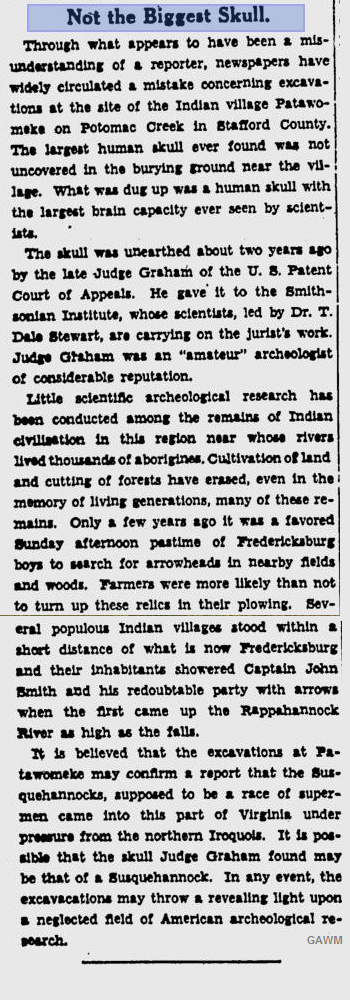Stafford County, Massive Brain Capacity
Not the Biggest Skull
Through what appears to have been a misunderstanding of a reporter, newspapers have widely circulated a mistake concerning excavations at the site of the Indian village Patawomeke on Potomac Creek in Stafford County. The largest human skull ever found was not uncovered in the burying ground near the village. What was dug up was a human skull with the largest brain capacity ever seen by scientists. The skull was unearthed about two years ago by the late Judge Graham of the U.S. Patent Court of Appeals. He gave it to the Smithsonian Institute, whose scientists, led by Dr. T. Dale Stewart, are carrying on the jurist’s work. Judge Graham was an “amateur” archaeologist of considerable reputation. Little scientific archaeological research has been conducted among the remains of Indian civilization in this region near whose rivers lived thousands of aborigines. Cultivation of land and cutting of forests have erased, even in the memory of living generations, many of these remains. Only a few years ago it was a favored Sunday afternoon pastime of Fredericksburg boys to search for arrowheads in nearby fields and woods. Farmers were more likely than not to turn up these relics in their plowing. Several populous Indian villages stood within a short distance of what is now Fredericksburg and their inhabitants showered Captain John Smith and his redoubtable party with arrows when they first came up the Rappahannock River as high as the falls. It is believed that the excavations at Patawomeke may confirm a report that the Susquehannocks, supposed to be a race of supermen came into this part of Virginia under pressure from the northern Iroquois. It is possible that the skull Judge Graham found may be that of a Susquehannock. In any event, the excavations may throw a revealing light upon a neglected field of American archaeological research.
The article “Not the Biggest Skull” offers a glimpse into the intriguing world of archaeological research, where mysteries from our past are waiting to be uncovered. Although the initial report about the discovery of the largest human skull ever found in the Indian village of Patawomeke turned out to be a misunderstanding, the skull that was actually found is still of great significance. It has the largest brain capacity ever seen by scientists, which challenges our preconceived notions about the capabilities of our ancestors.
The article also sheds light on the lack of scientific archaeological research in the region where thousands of aborigines lived. Due to cultivation of land and cutting of forests, many of the remains of Indian civilization have been erased from living memory. This highlights the importance of continuing research and exploration in the field of archaeology.
The excavations at Patawomeke have the potential to reveal new insights about the Susquehannocks, a supposed race of supermen who migrated to Virginia under pressure from the northern Iroquois. The skull that Judge Graham discovered may also provide clues about the origins of these people. It is important that we continue to explore and uncover the truth about our history, even if it challenges our preconceived notions and requires us to think outside the box.
- 1938. Fredricksburg VA Newspaper. http://zamzummim.org/
